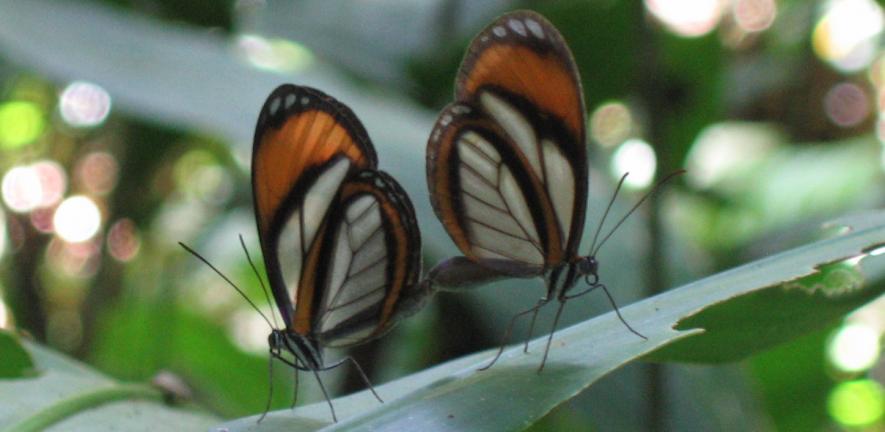
The spectacular variety of colours and patterns that butterflies use to ward off potential predators may result from highly localised environmental conditions known as “microhabitats”, researchers have found.
The spectacular variety of colours and patterns that butterflies use to ward off potential predators may result from highly localised environmental conditions known as “microhabitats”, researchers have found.
This is a really big question in science – why are there so many species, particularly in the tropical rainforests? Mimicry in these butterflies offers one opportunity to understand why the tropics are so incredibly diverse
Chris Jiggins
The study, by an international team of researchers, attempts to explain why, even though butterfly species have evolved to mimic one another’s wing patterns to more efficiently signal their toxicity, they nevertheless maintain a kaleidoscopic array of patterns overall.
This paradox applies not just to butterflies, but to a wide range of species, and addresses broader questions about how many different defensive strategies can be optimal in one place. Although many species have evolved warning colour patterns that signal to predators that they are bad to eat, there is still a remarkable diversity of these patterns. Scientists predict that all species should converge on the same pattern, but this has clearly not happened.
In the new study, the researchers focused on an area of Ecuadorian rainforest where butterfly species copy each other’s markings to deter insect-eating birds. The birds have learned that butterflies which exhibit certain patterns are toxic. There are, however, numerous different examples of these so-called “mimicry rings”, with the butterflies using a wide range of different colours and patterns to achieve the same result.
The researchers found that small and highly localised differences between parts of the forest, which are often only a few hundred metres apart, could explain why this happens. Although they do not seem dramatically dissimilar from one another, these microhabitats expose the butterflies to different predators. As a result, the pattern that is the most effective signal to predators may differ from one part of the forest to another.
The study was carried out by academics from the University of Cambridge, UK; the University of Florida, US; and the National Museum of Natural History/National Centre for Scientific Research in France.
Chris Jiggins, Professor of Evolutionary Biology at St John’s College, University of Cambridge, and a co-author, said: “This is a really big question in science – why are there so many species, particularly in the tropical rainforests? Mimicry in these butterflies offers one opportunity to understand why the tropics are so incredibly diverse.”
“What we found is that different insect-eating birds encounter different butterflies in these distinctive parts of the forest. This explains why, despite the effects of mimicry, the butterflies have maintained different patterns. Even though they are not living very far apart, they are signalling to different predators.”
The study is unusual in that the scientists examined this question by looking at predator species and their prey together – something which is often difficult to achieve. "This helped us to find evidence that supports earlier, theoretical predictions that microhabitat preferences in predators and prey could enhance mimicry diversity," co-author Marianne Elias, from MNHN/CNRS, said.
They studied an area of rainforest close to the Napo River, a tributary of the Amazon. A range of low hills there contains two distinctive microhabitats: small valleys with streams, and low ridges. These have slightly different natural features, such as subtle changes in light and temperature, and variations in plant life.
The team marked out four pairs of 30 metre-diameter plots, each consisting of either an area of valley or a section of ridge. They then documented the relationship between 64 species of butterflies (including 58 species of ithomiines, commonly known as clearwing butterflies), and 127 species of local insectivorous birds, including tyrant flycatchers, jacamars and antbirds. Ithomiine butterflies have evolved a number of contrasting mimicry rings, often using bright colours such as orange and yellow to warn the birds about their toxicity.
The researchers also studied the abundance of butterflies and their interactions with predators at different heights. “We threw ropes over the trees, climbed up and hung there in a harness to record how high the butterflies were flying,” Jiggins said.
They found that different butterfly mimicry rings gravitate towards topographically distinctive areas and fly at different heights. Similarly, different bird species tend to occur in different microhabitats.
These behavioural tendencies influence predation rates. At ridge sites, for example, birds targeted butterflies from the mimicry ring known as ‘eurimedia’ (which are yellow and black), more than a mimicry ring called ‘hermias’ (which have a tiger-like pattern, with intermingled orange, yellow and black). In valley sites, the situation was the reverse. The researchers showed this by putting dead butterfly specimens in the “wrong” areas, where the birds – clearly unfamiliar with their markings – attacked these specimens more than those displaying the locally abundant pattern.
Microhabitats are, however, probably only one of several causes of diversity in the butterflies’ mimicry rings. Other factors, such as seasonal variations in predators, or the fact that different species are active at different times of day, may also be significant.
The study adds to a developing picture of the very complex interrelationships between plants, herbivores and predators in which even small ecological changes can have a knock-on effect for multiple species and, it would seem, their diversity.
“Mimicry is a form of mutualism in which species are connected by each other’s presence,” Jiggins added. “In these amazingly diverse Amazonian rainforests there are lots of opportunities for such mutualistic interactions, which help to generate and stabilise diversity.”
The study, Maintaining mimicry diversity, is published in Proceedings of the Royal Society B.

The text in this work is licensed under a Creative Commons Attribution 4.0 International License. For image use please see separate credits above.
